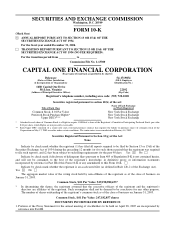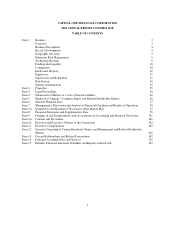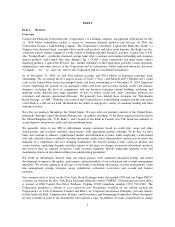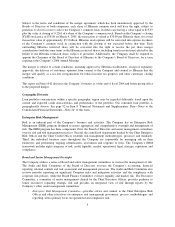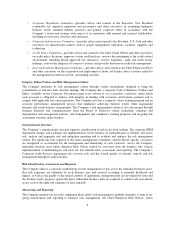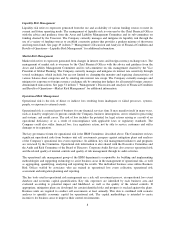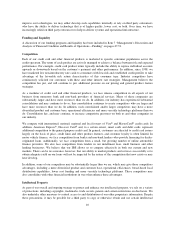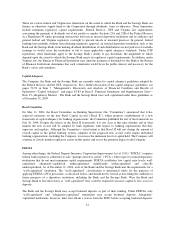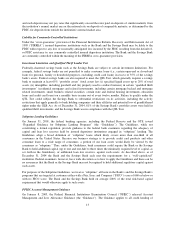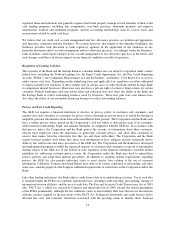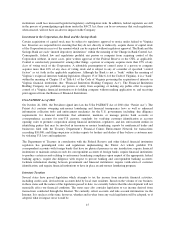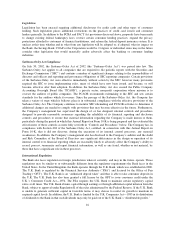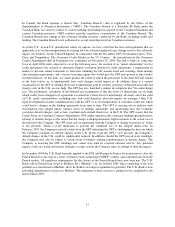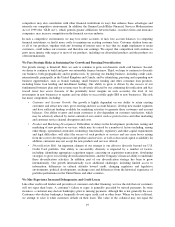Capital One 2004 Annual Report Download - page 33
Download and view the complete annual report
Please find page 33 of the 2004 Capital One annual report below. You can navigate through the pages in the report by either clicking on the pages listed below, or by using the keyword search tool below to find specific information within the annual report.improve our technologies, we may either develop such capabilities internally or rely on third party outsourcers
who have the ability to deliver technology that is of higher quality, lower cost, or both. Over time, we have
increasingly relied on third party outsourcers to help us deliver systems and operational infrastructure.
Funding and Liquidity
A discussion of our funding programs and liquidity has been included in Item 7 “Management’s Discussion and
Analysis of Financial Condition and Results of Operations—Funding” on pages 47-51.
Competition
Each of our credit card and other financial products is marketed to specific consumer populations across the
credit spectrum. The terms of each product are actively managed to achieve a balance between risk and expected
performance. For example, credit card product terms typically include the ability to reprice individual accounts
upwards or downwards based on the customer’s payment and other performance. In addition, since 1998, we
have marketed low non-introductory rate cards to consumers with low-risk and established credit profiles to take
advantage of the favorable risk return characteristics of this consumer type. Industry competitors have
continuously solicited our customers with these and other interest rate strategies. Management believes the
competition has put, and will continue to put, additional pressure on our pricing and general product feature
strategies.
As a marketer of credit card and other financial products, we face intense competition in all aspects of our
business from numerous bank and non-bank providers of financial services. Many of these companies are
substantially larger and have more resources than we do. In addition, our industry has experienced substantial
consolidation and may continue to do so; this consolidation continues to create competitors who are larger and
have more resources than we do. In addition, such consolidated and/or larger competitors may have a more
diversified product and customer base, operational efficiencies and more versatile technology platforms than we
do. Consolidation has, and may continue, to increase competitive pressures on both us and other companies in
our industry.
We compete with international, national, regional and local issuers of Visa®and MasterCard®credit cards. In
addition, American Express®, Discover Card®and, to a certain extent, smart cards and debit cards, represent
additional competition to the general purpose credit card. In general, customers are attracted to credit card issuers
largely on the basis of price, credit limit and other product features, and customer loyalty is often limited. In
motor vehicle finance, we face competition from banks and non-bank lenders who provide financing for dealer-
originated loans. Additionally, we face competition from a small, but growing number of online automobile
finance providers. We also face competition from lenders in our installment loan, small business and other
lending businesses. We believe that our IBS allows us to compete effectively in both our current and new
markets. There can be no assurance, however, that our ability to market products and services successfully or to
obtain adequate yield on our loans will not be impacted by the nature of the competition that now exists or may
later develop.
In addition, some of our competitors may be substantially larger than we are, which may give those competitors
advantages, including a more diversified product and customer base, operational efficiencies, broad-based local
distribution capabilities, lower cost funding and more versatile technology platforms. These competitors may
also consolidate with other financial institutions in ways that enhance these advantages.
Intellectual Property
As part of our overall and ongoing strategy to protect and enhance our intellectual property, we rely on a variety
of protections, including copyrights, trademarks, trade secrets, patents and certain restrictions on disclosure. We
also undertake other measures to control access to and distribution of our other proprietary information. Despite
these precautions, it may be possible for a third party to copy or otherwise obtain and use certain intellectual
10



